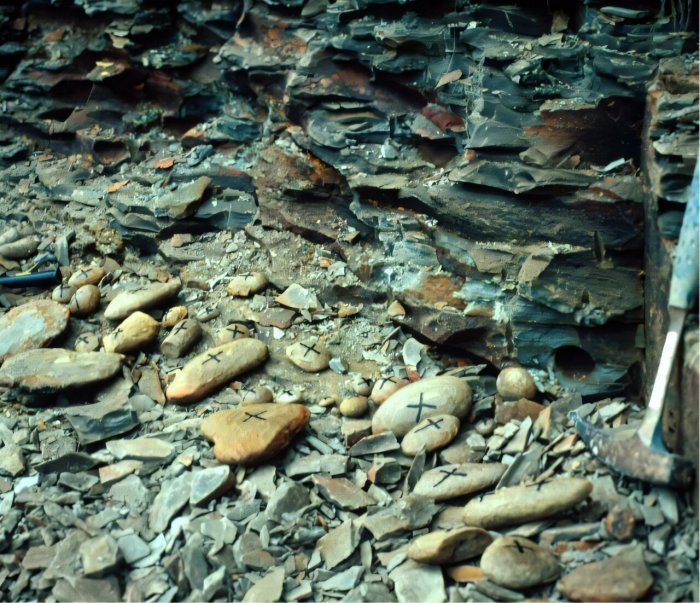Eddie Gonzales Jr. – AncientPages.com – Over 300 million years ago, during the Carboniferous Period, the region now known as northern Illinois, excluding Chicago, was characterized by vibrant ecosystems.

A Tully Monster (Tullimonstrum gregarium). Image credit: University of Missouri
This area, which includes the Mazon Creek fossil site (pronounced “muh-ZAHN”), was home to a diverse array of ancient creatures. These organisms thrived in environments such as lush tropical swamps, river deltas, and shallow seas.
Researchers at the University of Missouri’s College of Arts and Science are working with geologist Gordon Baird to reexamine his extensive fossil collection from Mazon Creek, currently stored at the Field Museum in Chicago.
This collection comprises 300,000 siderite concretions sourced from approximately 350 different sites. The Mazon Creek fossil beds are famous for their remarkable preservation of both plant and animal life, a result of their distinct geological conditions.
The fossils are encased in siderite, an iron carbonate mineral, forming numerous concretions that have become invaluable to scientists and amateur fossil enthusiasts alike.
Decades of research at Mazon Creek, including pivotal fieldwork by Baird and his team in the late 1970s, have provided us with an exceptional understanding of ancient coastal life.
A snapshot of ancient life
Baird’s pioneering research at the Mazon Creek fossil site was instrumental in identifying two significant faunal assemblages, or groups of animal remains.
These assemblages have been crucial for scientists in reconstructing the ancient environments from which these fossils emerged.
The first is a marine assemblage, consisting of organisms that lived in offshore coastal waters. The second is a mixed assemblage found in a river delta along the shoreline, where both freshwater organisms and terrestrial plants and animals transported by water were preserved together.

Concretions. Image credit: Gordon Baird
Mizzou’s team has recently validated a more detailed interpretation of Baird’s initial findings. They achieved this by employing contemporary data analysis methods alongside advanced imaging technologies available at Mizzou’s X-ray Microanalysis Core.
“We found three readily identifiable paleoenvironments, including the unique characteristics of a benthic marine assemblage representing a transitional habitat between the nearshore and offshore zones,” said Jim Schiffbauer, Marie M. and Harry L. Smith Endowed Professor of Geological Sciences. “These ancient environments were each dominated by specific groups of animals, for example freshwater animals nearest to shore, jellyfish and sea anemones further offshore, and marine clams and worms in the transitional zone.”
The fossils formed during a phase of sea-level rise and flooding of what used to be large coal swamps.
“The different environments affected how quickly and deeply organisms were buried, and in what specific geochemical conditions fossilization may have started,” Schiffbauer said. “That, in turn, shaped where certain microbes lived and helped form the minerals that make up the concretions surrounding these fossils today.”
Next steps
In current and future research, Schiffbauer and Baird are using this information to create a sedimentological model to show how the Mazon Creek ecosystem connects to the Colchester coal layers below — where coal mining led to the fossil site’s original discovery.

Field collection of concretions. Credit: Gordon Baird
“Given that multiple episodes of rapid coastal drowning events occurred in the U.S. midcontinent during the Carboniferous Period, refinement of information from the Mazon Creek locality will lead to a deeper understanding of similar deposits in other coal basins,” said Baird, who is now an emeritus professor at State University of New York at Fredonia.
The recent collaborative analysis conducted by Mizzou, in partnership with Baird, private sector colleagues, and the University of Toronto, offers the most comprehensive and data-driven depiction of Mazon Creek’s ancient ecosystem.
This research significantly enhances our understanding of biodiversity and paleoecology during the Carboniferous Period.
“It offers a real snapshot of the incredible diversity present in the late Carboniferous Period and allows for inferences about the complexity of food chains and how this ecosystem functioned,” Schiffbauer said.
“Now, we have an unparalleled and statistically supported look at the interconnected terrestrial, estuarine and marine life of the Carboniferous Period.”
Source
Paper
Written by Eddie Gonzales Jr. – AncientPages.com – MessageToEagle.com Staff Writer‘
